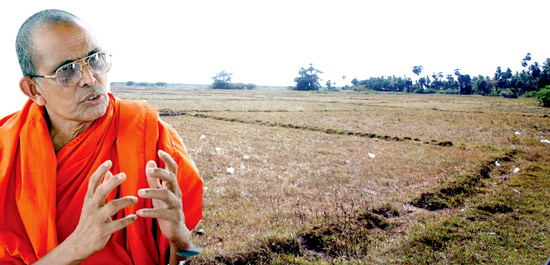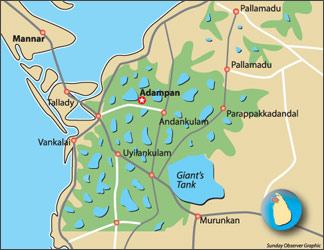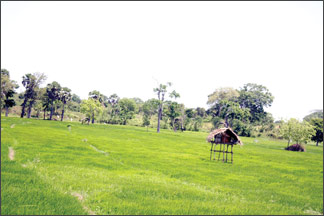In search of the magnificent past of Mannar
An attempt to unearth the undiscovered history:
 |
| Ven.Ellawala Medhananda thero |
Long strech of abandoned
paddy fields in the rice bowl is a common sight now |
At present, Mannar seems to be in the limelight than any city of the
country. In fact, it was a significant city of the ancient Sri Lanka as
an important trading port apart from its worthiness for its most fertile
land and high yields of rice.
As the security forces march forward towards the North it seems to be
that we are discovering more and more hidden stories of our own lands
those we have ‘lost’ in the sea of time.
Mannar is one of the villages adjoining the Mahathiththa or the great
port (opposite Mannar) on the North Westen coast of the island, said
Venerable Ellawala Medananda thero when I met him at his residing temple
in Getahettha, Avissawella.
Though he was feeling unwell, I was extremely grateful towards
Medhananda thero for his willingness to explain the history of the land.
I was digging the history of this newly liberated land from the clutches
of the LTTE, since the day I started to visit the area.
Yet it was saddening that it was very difficult to find related
literature based on research and surveys of the area except the book
Medhananda thero has written on the historical importance of the North
and the East.
|

Source: History of Sri Lanka-W.I.Siriweera |
“Apart from my personal visits to those areas I did from time to
time, no proper archaeological survey has been done by the authorities,”
venerable thero added. Meeting Medhananda thero was vital in my
demanding search for the history of Mannar and the Rice bowl that falls
to the Manthai west.
According to W. I. Siriweera as he mentions in his book ‘History of
Sri Lanka’, Mahathiththa that is exactly located opposite Mannar on the
North Westen coast facing the Arabian sea was the most important trading
port of the island in the period prior to the thirteenth century.
According to the findings of Siriweera Mahathiththa is variously
referred to as Mahavoti, Mahaputu, Mahavatu, Mahavatuthota, Mahapattana
and Matota and while it is called Mattottam in Tamil.According to
archaeologists a large number of articles of foreign origin including
coins and porcelainware have been excavated at Mahathiththa.
“The recently liberated area, Vedithalathivu, which is towards the
North of Mahathiththa is an island close to the area where the ‘Nay Aru’
river falls in to the sea. This river flows from Vavuniya and more
towards north we find the ‘Parangi Aru’ that falls to the sea at
Illuppaikadawai.
All these places act as small natural ports. This geographical
location definitely would have supported the LTTE to transport their
goods towards inland and outside as well,” Medhananda thero added.
According to him the port has been called as Meepathota by the
ancient Sri Lankans from where relationship with the Indian continent
has been conducted in the medieval period.The importance of Mahathiththa
as a port attracted many foreign invasions to our land.
During ancient kings time an administrative officer has been
specifically assigned to control the transactions taking place at this
port and they were named as ‘Maputuladdan’.
This was the most important port for vessels coming from South India.
According to Siriweera, Mahathiththta continued as the chief port of
Rajarata at least up to the thirteenth century but did not entirely lost
its glamour between the seventh and the twelfth centuries due the shift
in the trade trends from the west coast to the east, and it functioned
as an important trading centre where South Indian merchants flourished.
Anuradhapura era
|

Giants’ tank and its adjoiny tanks and irrigation canals |
The Anuradhapura kingdom was divided by the Kings to four parts -
Uththara (North), Pashchima (West), Pachina (East) and Dakkhina (South).
Uththara or the North is believed to be areas in Mannar, Giants’ tank
and the Jaffna peninsula. In the ancient Lanka the Jaffna peninsula was
known as ‘Nagadeepa’ - though the name refers to an island in the
peninsula.
The ancient area was towards the North of the Elephant Pass.
According to historical evidence there has been a separate officer under
the King, to operate the administration of the area. “During my visits
in the rice bowl, I found some ruins - stone pillars, graffiti etc - on
soil hills scattered all over the plain,” Medhananda thero added.
There are many archaeological evidences, especially found from the
Thiruketheeswaram temple site to prove there have been Buddhist temples
and shrines in the area. Accordingly, there have been temples such as
the Rakkha Viharaya, Na Vehera where the ruins were present and
Samadethiya which is also mentioned in Buddhist literature as ‘Maha Bo
Panan Wahanse’ which believed to be meaning the Natha Bodhi Saththwa.
Yet the statue to prove the fact has not yet been found.
The irrigation system

The Giants’ tank |

Paddy fields in Government controlled areas in Mannar |
According to folklore of the area the Giants’ tank is believed have
been built by King Saddhathissa but there is no proven evidence to find
the king who built the tank.
According to historical literature written directly and indirectly on
this particular area, it is said that during one harvest 134,000 sacks
of rice was produced. This area was important for the King who ruled the
Northern part of the country (in Anuradhapura) as the rice providing
area in similar to Digamadulla and areas in its vicinity were important
to the King who ruled the South.
It was evident as the King has always appointed a close relative of
his to govern this land.With the fall of the Anuradhapura kingdom and
the drift towards Pollonnaruwa and then to the Southern parts of the
country led to the decline of Mahathiththa - the great port.
In the foreign trade
Sri Lanka’s central position in the Indian Ocean along the maritime
trade routes and the adequate facilities provided through its numerous
bays and anchorages made the country a centre of transit trade from very
early days.
Natural products such as gems, pearls, ivory and spices were in
demand in export trade.
Sri Lanka was an important trading centre for the merchants of
Persia, Abyssinia, China and India.
Sri Lanka has been the most important points in the trade routes of
the ancient world thus bring in good luck as well as bad luck as this
facility has always attracted traders as well as invaders to our land. |
